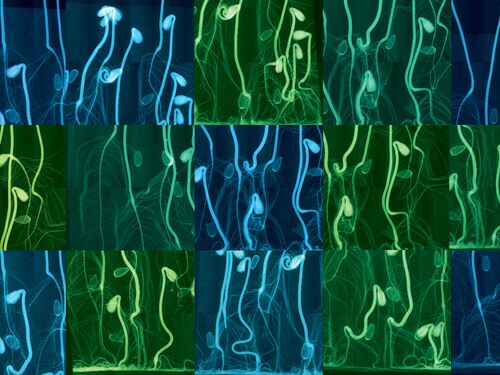Why are native seeds important?
Based on Science
Native plants provide the foundation for environments to support pollinators (like bees), butterflies, birds, and other life above and below ground. However, the supply of native seeds to restore and conserve ecosystems often falls short of demand.
Last update May 22, 2025
Pictured: Dornith Doherty, Sunflowers, 2009, dye coupler lenticular photograph, 29.75 x 48.5 inches. Permanent collection of the National Academy of Sciences. This print was part of the exhibition, Dornith Doherty: Archiving Eden, presented at the National Academy of Sciences in 2019.
Native plants have adapted to their specific environment.
Native plant materials—including seeds, cuttings, and young plants grown in containers—are essential to restoring and sustaining healthy ecosystems, especially as climate change is accelerating biodiversity loss and habitat degradation.
Being native to a specific region means these plant materials are finely tuned to the local soil and climate conditions and also provides the foundation for a healthy ecological relationship. Native plants provide high-quality food and habitat for native pollinators, birds, and other wildlife species, which have evolved over thousands of years, making them more resilient and better able to support biodiversity in that region than non-native plants.
When restoring land that has been damaged—for example, from wildfires or during road construction—it is important to use adapted native seeds from a region or ecologically similar area, as it can improve the success and long-term sustainability of these efforts. Using adapted native seeds ensures that ecosystems will recover in ways that improve their ecological function and leads to significantly higher plant diversity and better recovery compared to using non-native seed mixes.
Restoration needs native seeds but demand far exceeds supply.
Properly restoring degraded landscapes requires massive volumes of native seed. Yet the U.S. native seed supply chain struggles with limited production, unpredictable demand, and other logistical barriers.
For example, after wildfires in the West, agencies like the Bureau of Land Management may purchase up to 7 million pounds of seed in a single season. Depending on the affected ecosystem, effective restoration efforts use seed mixes from different plant species and prefer seeds originally collected from the regionally adapted plant communities.
People who produce these seeds have difficulty meeting these needs for a variety of reasons:
Growers need advance notice or financial assurance.
Seeds must be first collected, then increased by growing them in managed fields.
Seeds are perishable and storing large amounts can be costly.
If there is a year when demand does not materialize, growers risk losing both their product and their investments.
Solutions are available. Everything from forward contracting to regional seed partnerships to federal agencies streamlining their policies and practices to prioritize the correct seeds can all help match supply with anticipated demand. These strategies help to share the financial risk and create clearer market signals for producers.
Climate change challenges the “local is best” approach.
In the past, restoration experts followed the “local is best” rule—using seeds only from nearby areas. But climate change is causing local conditions to shift, making this rule harder to follow and raising questions about how far seeds should be moved and what traits matter most for long-term resilience. Seeds from nearby places may no longer be the best fit for the future environment.
To respond, some restoration efforts are experimenting with climate-adjusted provenancing, a new method that uses seed from areas with climates similar to what the restoration site is expected to experience in the future. For example, with the climate in Chicago becoming more like the climate in St. Louis, using seeds adapted to warmer and drier conditions may lead to better results. This emerging approach involves careful consideration to maintain genetic diversity, match the seed to the local environment, and avoid potential unintended consequences like losing local plant traits or introducing plants that will not thrive.
Tribal knowledge and local partnerships play critical roles.
Across the country, Tribal nations, local nonprofits, and community organizations are implementing native seeds and plant initiatives. For example, in Montana’s Northern Great Plains and adjacent Tribal lands, the Fort Belknap Indian Community launched a 5-year partnership with the Bureau of Land Management and the Society for Ecological Restoration to implement the Seeds of Success program, which focuses on the role of traditional ecological knowledge in ecological restoration.
Local groups like The Native Plant Center in New York work with volunteers, students, and regional governments to restore native plant communities and expand public awareness. These partnerships, while often under-resourced, are critical for increasing a steady demand for native plants that can influence and help build a robust market for native seeds.
What you can do to help:
Plant native seeds in your yard or community garden. Use regional guides or check with a local native plant society.
Ask for native species at your local nursery—and look for local “ecotypes” adapted to your region—avoid seed packets that do not list the origin or species (National Wildlife Federation).
Support native seed producers and policies that increase funding and coordination.
Volunteer with local restoration projects, land trusts, or botanical gardens.
Native seeds may be small, but their impact is vast. Restoring the landscapes we depend on starts with planting the species that naturally reside there.
ADDITIONAL RESOURCES
An Assessment of Native Seed Needs and the Capacity for Their Supply: Final Report (NASEM, 2023)
An Assessment of the Need for Native Seeds and the Capacity for Their Supply: Interim Report (NASEM, 2020)
The Native Plant Center at SUNY Westchester Community College
Plant Science & Conservation at the Chicago Botanic Garden
Lady Bird Johnson Wildflower Center – The Botanic Garden of Texas
Disclaimer: Initial brainstorming and outlining for articles in this series, produced in 2025, may include input generated with the assistance of ChatGPT. Human experts review all AI-supported content to ensure factual accuracy, relevancy and the appropriate context.




